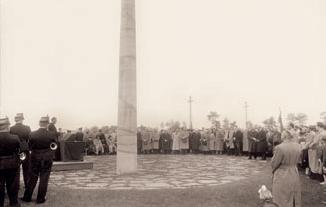Early Forms of Commemoration
The First Commemorative Ceremonies
In the early post-war years, the commemorative ceremonies in Ohlsdorf cemetery, where many victims of the Nazi regime are buried, were jointly organised by the Free and Hanseatic City of Hamburg, its political parties, and the local survivors’ associations. An urn holding the ashes of an unidentified prisoner from Buchenwald formed the focal point of the very first of such a ceremony. This urn was later interred at the central “Memorial to the Resistance Fighters and Victims of National-Socialist Persecution”. At the inauguration of this memorial in 1949, the Cold War made itself clearly felt: the Hamburg Senate refused to hold a joint ceremony with the Communist-dominated “Association of Persecutees of the Nazi Regime” (VVN) and brought its inauguration ceremony forward to May 3. On May 8, the VVN held its own ceremony on the occasion of the 4th anniversary of Germany’s liberation.

Pilgrimages to Neuengamme
People from outside Germany who travelled to the sites of the former concentration camp often regarded such journeys as pilgrimages. They would visit the grounds, sing national or religious songs and say prayers. For the survivors and relatives of prisoners who had been killed, theprisoners’ barracks with the parade ground was of special significance as a place of suffering, as was the crematorium. Tothis day, victims’ relatives take soil from the site of the crema-torium home with them. For years, there was no public accessto these places. Visitors from abroad either drove around thegrounds or flew over them in order to catch a glimpse of the formercamp. The site where the crematorium used to stand was only madeaccessible and marked in 1970. The site of the prisoners’ barracks only became part of the Neuengamme memorial in 2003.
The First Monument
To many survivors and relatives of victims, it was unbearable not to have a place for grieving and commemoration on the actual site of the former camp. The French government exerted pressure on the Senate to find a solution to this problem. Access to the site of the crematorium and the erection of a monument became particularly important issues in this debate. The German side refused to grant access to the site of the crematorium, arguing that it was impossible to locate. Eventually, both sides agreed on the erection of a monument on the site of the former camp nursery. This monument was inaugurated on 18 October 1953. Responding to pressure from the AIN, the international survivors’ association, the Hamburg Senate added a stone cube with an inscription in 1960.
On October 18, 1953, a simple, seven-metre-high shell limestone column designed by director of construction Paul Seitz was inaugurated. Initially, this memorial site was dedicated to the French nationals who died at Neuengamme. The financial departmentof the Hamburg Senate suggested that it be dedicated to all the victims of the camp and that the inscription should express this as well. Senator of Justice Kröger chose the inscription: “Dedicated to the Victims 1938–1945”.
